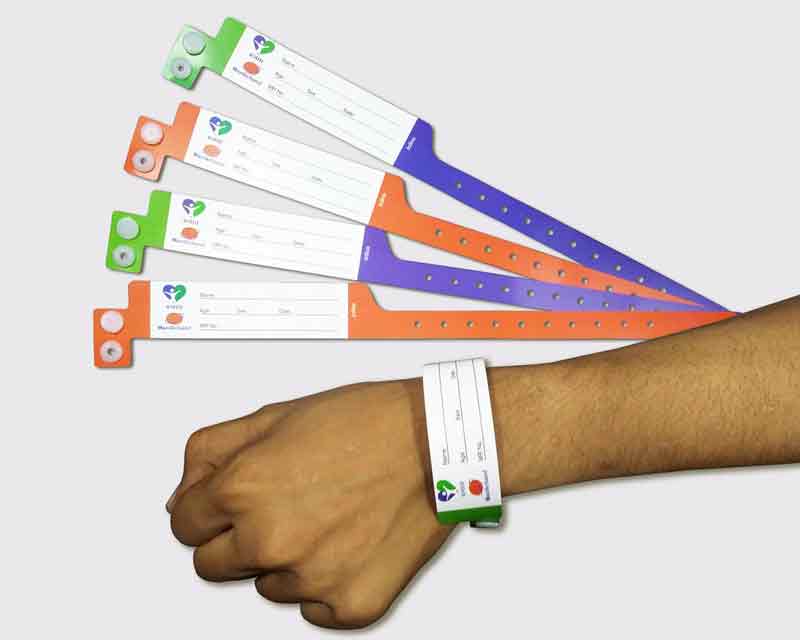How a Patient Identification Band Improves Patient Treatment and Reduces Risks
How a Patient Identification Band Improves Patient Treatment and Reduces Risks
Blog Article
Discovering the Numerous Sorts Of Patient Identification Band Made Use Of in Clinical Facilities
In the intricate world of healthcare, the essential duty of Patient Identification bands commonly goes unnoticed. These bands, varying from straightforward paper wristbands to innovative RFID bands, form the backbone of Patient safety and security methods, making sure accuracy in Patient Identification.
Recognizing the Importance of Patient Identification Bands
While they might seem like plain devices, Patient Identification bands play a crucial role in clinical facilities. These bands serve as an essential device for verifying Patient identity, avoiding clinical mistakes connected to misidentification. Patient Identification bands likewise aid in simplifying management jobs, guaranteeing accurate record-keeping and billing.
Conventional Paper Wristbands: Their Usage and Limitations
Conventional paper wristbands have been a staple in Patient Identification throughout different medical facilities. While their use prevails, they harbor certain limitations that might affect their effectiveness in Patient management. This area will concentrate on the range of their application and the integral downsides related to their use.
Paper Wristbands: Use Scope
In the world of Patient Identification, paper wristbands have actually long held a critical duty. These bands are usually made use of in outpatient setups, where the Patient's remain is temporary. The wristbands contain necessary details such as the Patient's name, date of birth, and a special Identification number. This easy, yet reliable system, enables doctor to promptly and precisely determine individuals, guaranteeing the appropriate therapy is provided. Paper wristbands are additionally utilized in emergency situation situations, where quick Identification is paramount. Their usage includes events like blood contribution drives and mass inoculation programs, even more stressing their versatility. Despite advancements in technology, the modest paper wristband remains a economical and trusted service for Patient Identification in various health care situations.
Limitations of Paper Wristbands
In spite of their widespread use, paper wristbands are not without their downsides. Their physical longevity is one of the significant limitations. Exposure to water, sweat, or rough handling can make them unreadable and even cause them to disintegrate. Furthermore, paper wristbands usually lack the technical capacities of even more modern alternatives, such as barcoding or RFID chips, restricting their capability to just displaying created details. The failure to update or modify the information on the wristband is an additional imperfection. If the info is transcribed, legibility can be jeopardized, leading to prospective misidentification. Lastly, paper wristbands can cause discomfort or skin inflammation to some clients, especially when worn for extended durations.
Barcoded Wristbands: Advancements in Patient Identification
While Patient Identification has actually long been a critical aspect of medical care, the advent of barcoded wristbands represents a substantial leap ahead. These bands take advantage of the simpleness of barcoding technology, allowing for Patient information to be promptly checked and accessed. They enhance the rate and precision of Patient Identification, lowering the risk of clinical mistakes connected to misidentification.
Superhigh Frequency Identification (RFID) Bands: a Step In The Direction Of Futuristic Medical Care
The development of Patient Identification bands has brought concerning the emergence of Radio Regularity Identification (RFID) Bands (patient identification band). These innovative tools present key benefits for medical care centers, using an extra effective and highly advanced means of Patient Identification. The implementation of RFID in medical care is a considerable action towards a more advanced method to Patient management and safety and security
Comprehending RFID Bands

RFID Bands: Trick Advantages
Embracing a future where modern technology and health care combine, radio frequency Identification bands use several key advantages. Largely, these bands improve Patient safety by see this here giving accurate, immediate Identification, therefore lowering clinical errors. RFID bands can keep a vast quantity of Patient data, including clinical background and allergic reactions, allowing personalized treatment. They likewise simplify administrative jobs, as the automated information entry replaces hands-on procedures, boosting performance and reducing documentation. RFID bands provide real-time monitoring of people, important in high-risk environments such as surgery or extensive care. Finally, these bands are long lasting and resistant to ecological aspects, guaranteeing consistent capability. Overall, RFID bands stand for a considerable advancement in Patient Identification innovation, profiting both people and doctor.
Executing RFID in Health Care
These bands provide a seamless way to track and determine people, ensuring their security and improving effectiveness in therapy procedures. RFID bands minimize clinical errors by giving accurate Patient Identification, which is important in stopping misdiagnosis or wrong medicine administration. Thus, the implementation of RFID bands is a substantial step towards enhancing Patient safety and security and healthcare distribution.

Color-Coded Wristbands: Helping in Quick and Accurate Diagnosis
In the bustling from this source atmosphere of a clinical facility, color-coded wristbands have arised as essential tools for swift and precise Identification of a person's medical problem. These wristbands, put on by people, lug details shades that match to various clinical conditions or conditions. This system is developed to use immediate visual hints to healthcare providers, improving Patient security and care quality.
Methods for Efficient Implementation and Monitoring of Patient ID Bands
Accomplishing optimal use of Patient Identification bands necessitates a well-structured strategy for their execution and management. The initial step includes training all wellness employees on the importance of appropriately using and reviewing these bands. Second of all, health centers need to systematize using ID bands throughout all divisions, guaranteeing uniformity and reducing disparities. Normal audits needs to be performed to verify adherence to plans and to fix any kind of incongruities. Patient education and learning is additionally vital; individuals have to recognize the objective of the bands and the demand for their constant wear. patient identification band. It's necessary to have a back-up strategy in location, such as barcode scanning or biometrics, to make certain that Patient Identification is never endangered.
Conclusion
Patient Identification bands are crucial in medical facilities to make certain security and accuracy. Standard paper, barcoded, RFID, and color-coded wristbands each hold special benefits, ranging from cost-effectiveness to advanced information storage and instantaneous medical signals. Efficient application and management of these bands can dramatically decrease medical errors, improve performance, and enhance total Patient treatment. Therefore, understanding and making use of these Identification devices is extremely important for preserving high criteria in medical care.
These bands, differing from simple paper wristbands to sophisticated RFID bands, develop the foundation of Patient safety and security methods, ensuring accuracy in Patient Identification.The development of directory Patient Identification bands has brought regarding the appearance of Radio Regularity Identification (RFID) Bands. Overall, RFID bands represent a substantial innovation in Patient Identification modern technology, benefiting both clients and medical care carriers.
RFID bands lower clinical mistakes by supplying exact Patient Identification, which is vital in protecting against misdiagnosis or wrong medication management. Patient education is additionally crucial; people should comprehend the objective of the bands and the need for their constant wear.
Report this page